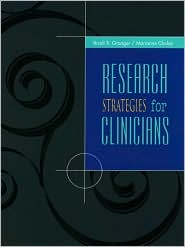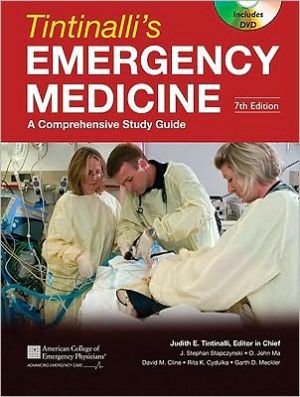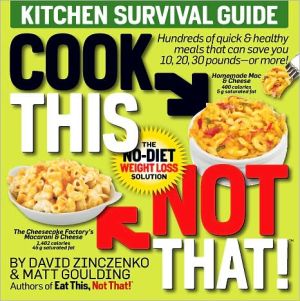Research Strategies for Clinicians
This brand new book takes a pragmatic approach to nursing research, providing theory plus practical suggestions on how to carry out research when employed in a clinical facility. Designed in a text/workbook format to encourage "hand on" use, the book is a useful supplement to any introductory nursing research text or graduate nursing research course. It helps nurses identify high priority research questions, find sources for statistical help, and prepare research results for publication....
Search in google:
This brand new book takes a pragmatic approach to nursing research, providing theory plus practical suggestions on how to carry out research when employed in a clinical facility. Designed in a text/workbook format to encourage "hand on" use, the book is a useful supplement to any introductory nursing research text or graduate nursing research course. It helps nurses identify high priority research questions, find sources for statistical help, and prepare research results for publication. Chapter highlights, help boxes, and exercises make research concepts come alive. Nurses, advance practice nurses, undergraduate and graduate nursing students, and instructors. Melanie S. Percy This book is an excellent "how-to" research book for clinicians. It is interesting, well written, and basic without being condescending. It is written to help the clinical nurse overcome the "roadblocks to research completion in clinical practice." This book is targeted to nurses in practice at all levels, from entry to advanced practice. The book begins with the most elementary, practical question, "why do research in clinical practice?" After making the argument that practice is improved by research, the authors proceed to the next question "so, how do I do it?" The rest of the book includes examples, worksheets, exercises, and algorithms to help the clinician through the first research project. Appendixes are particularly useful because they offer a complete IRB proposal, templates for protocols, and case report forms. There is even a final chapter on finding research support, tips on submitting research articles for publication, and a sample poster presentation in the chapter on dissemination. Throughout the book there is a sense of excitement about research. I have never encountered this in any of the research books I have used previously. In comparison to current research books, this one is practical, easy to understand, compelling, and full of exercises that will actually help the clinician to be successful.
1. Improving Outcomes through Research. 2. Clinical Questions: Where Do You Find Them? 3. Prioritizing Clinical Questions. 4. Research Teams: Getting Started and Keeping Momentum. 5. Pragmatic Approaches to Reviewing the Literature. 6. Protocol Development: Keep it Simple Strategies for the Novice and Expert. 7. Getting through the Approvals Process. 8. Data Analysis. 9. Sharing Your Findings.10. Finding Resources to Support Research.Appendix 1. Protocol Examples.Appendix 2. Sample Case Report Forms.Appendix 3. Examples of IRB Forms.Appendix 4. Code of Federal Regulations.Appendix 5. Answers for Exercises.Index.
\ From The CriticsReviewer: Melanie S. Percy, RN, PhD, CPNP(University of Texas at Austin School of Nursing)\ Description: This book is an excellent "how-to" research book for clinicians. It is interesting, well written, and basic without being condescending. \ Purpose: It is written to help the clinical nurse overcome the "roadblocks to research completion in clinical practice."\ Audience: This book is targeted to nurses in practice at all levels, from entry to advanced practice. \ Features: The book begins with the most elementary, practical question, "why do research in clinical practice?" After making the argument that practice is improved by research, the authors proceed to the next question "so, how do I do it?" The rest of the book includes examples, worksheets, exercises, and algorithms to help the clinician through the first research project. Appendixes are particularly useful because they offer a complete IRB proposal, templates for protocols, and case report forms. There is even a final chapter on finding research support, tips on submitting research articles for publication, and a sample poster presentation in the chapter on dissemination. \ Assessment: Throughout the book there is a sense of excitement about research. I have never encountered this in any of the research books I have used previously. In comparison to current research books, this one is practical, easy to understand, compelling, and full of exercises that will actually help the clinician to be successful.\ \ \ \ \ Melanie S. PercyThis book is an excellent "how-to" research book for clinicians. It is interesting, well written, and basic without being condescending. It is written to help the clinical nurse overcome the "roadblocks to research completion in clinical practice." This book is targeted to nurses in practice at all levels, from entry to advanced practice. The book begins with the most elementary, practical question, "why do research in clinical practice?" After making the argument that practice is improved by research, the authors proceed to the next question "so, how do I do it?" The rest of the book includes examples, worksheets, exercises, and algorithms to help the clinician through the first research project. Appendixes are particularly useful because they offer a complete IRB proposal, templates for protocols, and case report forms. There is even a final chapter on finding research support, tips on submitting research articles for publication, and a sample poster presentation in the chapter on dissemination. Throughout the book there is a sense of excitement about research. I have never encountered this in any of the research books I have used previously. In comparison to current research books, this one is practical, easy to understand, compelling, and full of exercises that will actually help the clinician to be successful.\ \ \ 3 Stars from Doody\ \








